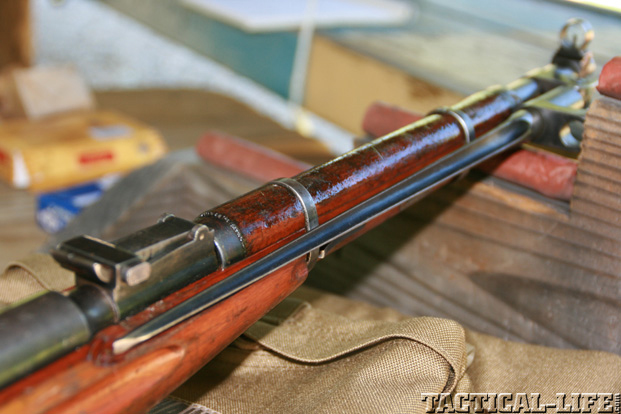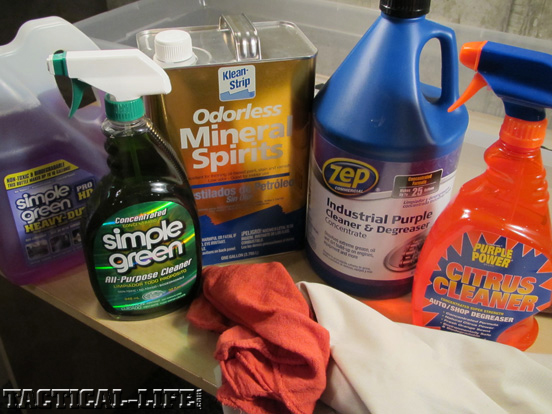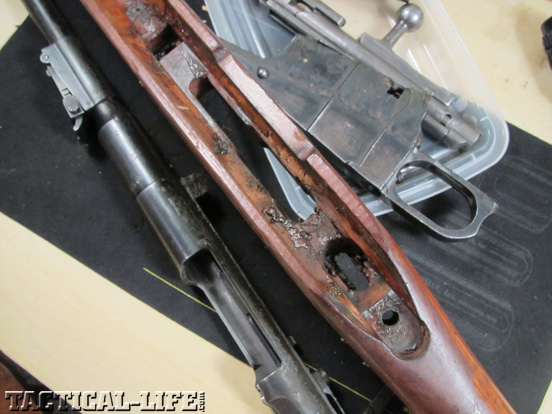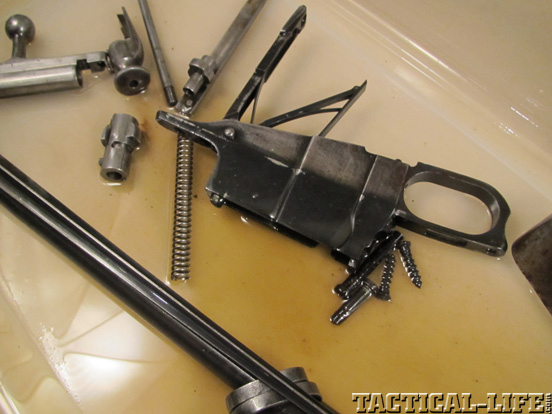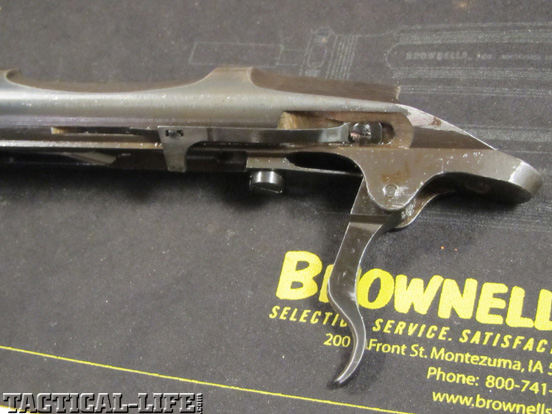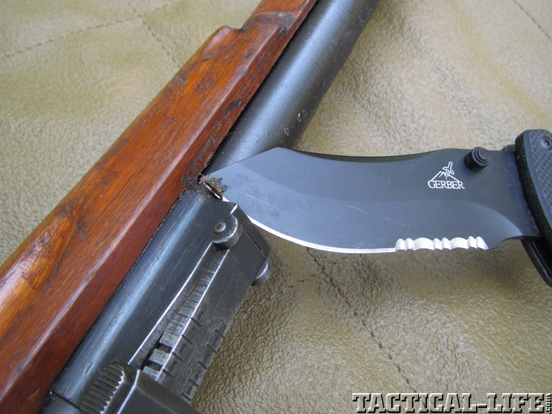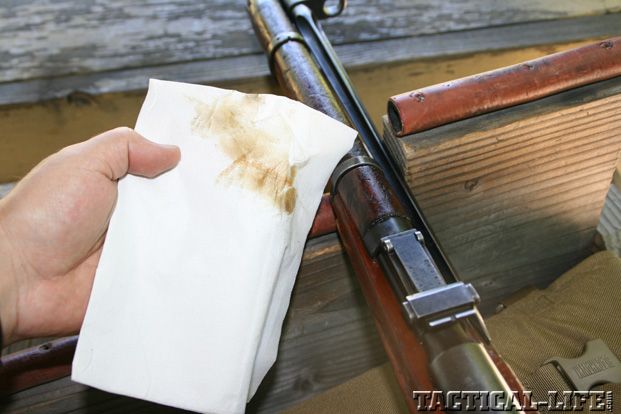Mention cosmoline to old-time leathernecks or to most military veterans, and you will likely get grimaces of disgust as they remember the chore of removing the sticky goo from their rifles: Cosmoline is made to enter every crevice and coat every part of a mechanism. Back in the day, everything from gasoline, kerosene and diesel fuel was used to ready rifles for inspection. I have even heard stories of World War II aircrews using boiling water to remove grease from .50 caliber Browning machine guns. I do not recommend any of the abovementioned solvents for de-gunking your surplus rifles. There are safer methods, even environmentally-friendly ones.
Notorious Cosmo
“Cosmoline” was at one time trademarked, and it is now used as the generic term for grease preservatives. The job of cosmoline and its ersatz counterparts is to protect and preserve metal from rust during long-term storage. Decades ago, it not only protected rifles but also tanks, naval guns, tools and all sorts of metal equipment. This was especially important when equipment was shipped by boat and subjected to seawater and salt air. At best, it is a sticky grease; at worst, a waxy gunk. Either way, it can be difficult to completely remove. Note that cosmoline has a melting point between 113 and 125 degrees Fahrenheit. Paraffin’s is between 130 to 145, and that of candle wax (like the decorative candles in your home) is between 145 and 150.
If you plan on shooting a military surplus rifle, it is imperative to remove the storage grease—if you don’t, the rifle won’t operate. This is especially true with semi-automatic rifles like SKSs or M1 Garands, which each utilizes a gas piston to cycle its action. Gas pistons need to be free of oil and grease, as they attract burnt powder and grit and eventually cause the rifle to malfunction: the firing pin and firing pin spring in bolt-action rifles can get clogged with grease and not release; in warmer climates, the grease will start to seep out of the gun and coat your hands in slime; and in colder temperatures, the grease will coagulate, sometimes seizing up a mechanism. So, how exactly do you deal with this on your new acquisition? Here’s an easy and effective method for getting rid of that grease and bringing your old rifle back into operation.
Advertisement — Continue Reading Below
Five-Step Cleanse
Prep: Before cleaning, make sure you have a clear, open workspace that is well lit and ventilated. You will also need a large plastic tub to hold the barreled action and all the other metal parts. I used a 41-quart plastic bin that measured 35 by 16 by 5 inches. Next is a degreasing solution: eco-friendly degreasers like Simple Green (no odor, biodegradable, nontoxic) or Purple Power Citrus Cleaner can be used. ZEP is another common degreaser I have used it in the past, but I prefer my old standby, low-vapor mineral spirits. Whatever solution you use, read the label. Buy at least one gallon since your particular firearm may need numerous applications. Also have on hand an old paintbrush, a toothbrush, rubber gloves and safety glasses. For the wood stock, you will need paper towels, a hair dryer, masking tape and black, plastic garbage bags.
1. Strip It Down: Completely disassemble your rifle. If you are at a loss on how to do so, there are numerous books that can show you how, or you can consult a gunsmith. The internet is also a great place to search, but remember that some online videos are dodgy and unreliable. The idea here is to reduce your firearm to a pile of parts.
2. Soak Metal Parts: Place all the metal parts in the plastic tub and pour the degreasing solution over them. Use the paintbrush to saturate the hard-to-reach areas and let the metal soak for a few hours or overnight, depending on the amount and age of the grease. As the solution becomes muddy with dissolved grease, replace it with fresh, clean solution. Use the toothbrush to scrub stubborn areas.
Advertisement — Continue Reading Below
3. Dry Metal Parts: Dry off the metal parts with clean, absorbent rags, and use canned air or an air compressor to blow out the solution and dissolved grease from hard-to-reach areas. Finally, clean the bore like you would after firing the firearm, and rub all metal surfaces with an oily cloth—less oil is better.
4. Wipe Down The Wood: Do not soak wood or synthetic stocks in the degreasing solution as it will soften and destroy the wood. Wipe out and gently scrap out the large clumps of grease in the action/barrel-bedding area and outside.
5. Leech The Wood: You will not be able to remove all the grease from the wood since the wood’s fiber will hold some in. There are two methods to removing grease from wood. The fast method is to use a hair dryer to heat the surface of the wood. As the wood heats, the grease will melt. You will know this is working when the wood begins to sweat and gloss and there is a distinct petroleum smell. Wipe the grease away with a paper towel, which will absorb the now liquid grease. A heat gun is another option, but you run the risk of burning the wood. A steamer works too, but you will raise the grain of the wood, which will need to be sanded down. It is very easy to quickly devalue a firearm by ruining the stock. As Fjestad’s “Blue Book” states, the need to have “crisp, clear cartouches cannot be overstated.” Work small sections of the stock at a time with the hair dryer. Try to remove the grease evenly so the stock does not look splotchy. When the stock does not appear glossy, you are finished.
Advertisement — Continue Reading Below
The other wood-leeching method takes longer. Stuff paper towels into the inletting of the stock, and completely wrap the stock with paper towels secured tightly against the wood with masking tape. Do not affix the tape to the wood—only use it to hold the paper towels to the wood. Next, wrap the stock (now encased in paper towels) in a black, plastic trash bag, and tightly wrap the bag around the stock using masking tape. Then place the stock outside in a heated area, such as in the sun, or in a hot, parked vehicle. The heat will help melt the grease, and the paper towels will absorb it as it leeches from the wood. (This wrapping technique may need to be repeated several times.) Finally, wipe down the wood with a clean soft cloth moistened with mineral spirits, to wipe away any remaining film. Do not saturate the wood, just wipe it down, and let it air dry. You’re done. Now reassemble the rifle.
Clean 53
To give this process a try, I procured a suitably greasy Chinese Type 53 carbine from Century International Arms, who uses a commercial washing machine and hot water to degrease their Type 53s. The rifle’s exterior was clean with only a film of grease, but that was not the case upon disassembly: simply removing the bolt from the action revealed smears of grease; when I took off the barrel bands and the handguard separated from the stock, I found some more, decades-old grease. Then, when I pulled the barreled receiver out of the stock and further disassembled the carbine, I saw that the action and trigger mechanism, magazine and every other part also needed attending to.
Applying the technique listed above, the metal from the Type 53 quickly came clean, without a lot of scrubbing. The stock had some finish left on it, which had a used, weathered look. The bore of the Type 53 had decades of crud in it, and after a pile a patches the final patch came out white.
With a little elbow grease you can take the grimiest of old military guns and bring it back into fighting form. And with a bit of extra effort, you can turn that beater into an impressive addition to your collection. Keep an eye out for surplus classics, and keep you cleaning gear at the ready! For more information, please call 800-527-1252 or visit centuryarms.com.
Advertisement — Continue Reading Below
